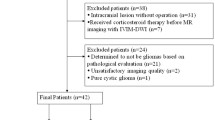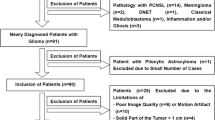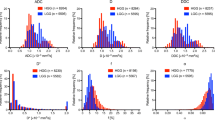Abstract
Objective
To assess whether ADC maps obtained from high b value DWI were more valuable in preoperatively evaluating the grade, Ki-67 index and outcome of gliomas.
Methods
Sixty-three patients with gliomas, who underwent preoperative multi b value DWI at 3 T, were enrolled. The ADC1000, ADC2000 and ADC3000 maps were generated. Receiver operating characteristic analyses were conducted to determine the area under the curve (AUC) in differentiating high-grade gliomas (HGG) from low-grade gliomas (LGG). Pearson correlation coefficients (R value) were calculated to investigate the correlation between parameters with the Ki-67 proliferation index. Survival analysis was conducted by using Cox regression.
Results
The AUC of the mean ADC1000 value (0.820) was lower than that of the mean ADC2000 value (0.847) and mean ADC3000 value (0.875) in differentiating HGG from LGG. The R value of the mean ADC1000 value (−0.499) was less negative than that of the mean ADC2000 value (−0.530) and mean ADC3000 value (−0.567). The mean ADC3000 value was an independent prognosis factor for gliomas (p = 0.008), while the mean ADC1000 and ADC2000 values were not.
Conclusion
ADC maps obtained from high b value DWI might be a better imaging biomarker in the preoperative evaluation of gliomas.
Key Points
• ADC 3000 maps could improve the differentiation between HGG and LGG.
• The mean ADC 3000 value had a closer correlation with the Ki-67 index.
• The mean ADC 3000 value was an independent prognosis factor for gliomas.


Similar content being viewed by others
Abbreviations
- ADC:
-
Apparent diffusion coefficient
- AUC:
-
Area under the curve
- DWI:
-
Diffusion-weighted imaging
- HGG:
-
High-grade gliomas
- LGG:
-
Low-grade gliomas
- NSA:
-
Number of scan averages
- ROC:
-
Receiver operating characteristic
- ROI:
-
Region of interest
- SNR:
-
Signal-to-noise ratio
References
Schwartzbaum JA, Fisher JL, Aldape KD, Wrensch M (2006) Epidemiology and molecular pathology of glioma. Nat Clin Pract Neurol 2:494–503
Weller M, van den Bent M, Hopkins K et al (2014) EANO guideline for the diagnosis and treatment of anaplastic gliomas and glioblastoma. Lancet Oncol 15:e395–e403
Soffietti R, Baumert BG, Bello L et al (2010) Guidelines on management of low-grade gliomas: report of an EFNS–EANO Task Force. Eur J Neurol 17:1124–1133
Murakami R, Hirai T, Kitajima M et al (2009) Magnetic resonance imaging of pilocytic astrocytomas: usefulness of the minimum apparent diffusion coefficient (ADC) value for differentiation from high-grade gliomas. Acta Radiol 49:462–467
Bai Y, Lin Y, Tian J et al (2016) Grading of gliomas by using monoexponential, biexponential, and stretched exponential diffusion-weighted MR imaging and diffusion kurtosis MR imaging. Radiology 278:496–504
Higano S, Yun X, Kumabe T et al (2006) Malignant astrocytic tumors: clinical importance of apparent diffusion coefficient in prediction of grade and prognosis. Radiology 241:839–846
Zulfiqar M, Yousem DM, Lai H (2013) ADC values and prognosis of malignant astrocytomas: does lower ADC predict a worse prognosis independent of grade of tumor?—A meta-analysis. AJNR Am Neuroradiol 200:624–629
Server A, Kulle B, Gadmar ØB et al (2011) Measurements of diagnostic examination performance using quantitative apparent diffusion coefficient and proton MR spectroscopic imaging in the preoperative evaluation of tumor grade in cerebral gliomas. Eur J Radiol 80:462–470
Doskaliyev A, Yamasaki F, Ohtaki M et al (2012) Lymphomas and glioblastomas: Differences in the apparent diffusion coefficient evaluated with high b-value diffusion-weighted magnetic resonance imaging at 3T. Eur J Radiol 81:339–344
Kitajima K, Takahashi S, Ueno Y et al (2012) Clinical utility of apparent diffusion coefficient values obtained using high b-value when diagnosing prostate cancer using 3 tesla MRI: Comparison between ultra-high b-value (2000 s/mm2) and standard high b-value (1000 s/mm2). J Magn Reson Imaging 36:198–205
Han C, Huang S, Guo J et al (2015) Use of a high b-value for diffusion weighted imaging of peritumoral regions to differentiate high-grade gliomas and solitary metastases. J Magn Reson Imaging 42:80–86
Zhang K, Shen Y, Zhang X et al (2016) Predicting prostate biopsy outcomes: a preliminary investigation on screening with ultrahigh b-value diffusion-weighted imaging as an innovative diagnostic biomarker. PLoS One 11, e0151176
Hyare H, Thornton J, Stevens J et al (2010) High-b-value diffusion MR imaging and basal nuclei apparent diffusion coefficient measurements in variant and sporadic Creutzfeldt-Jakob disease. AJNR Am Neuroradiol 31:521–526
Cihangiroglu M, Citci B, Kilickesmez O et al (2011) The utility of high b-value DWI in evaluation of ischemic stroke at 3T. Eur J Radiol 78:75–81
Yamasaki F, Kurisu K, Aoki T et al (2012) Advantages of high b-value diffusion-weighted imaging to diagnose pseudo-responses in patients with recurrent glioma after bevacizumab treatment. Eur J Radiol 81:2805–2810
Chu HH, Choi SH, Ryoo I et al (2013) Differentiation of true progression from pseudoprogression in glioblastoma treated with radiation therapy and concomitant temozolomide: comparison study of standard and high-b-value diffusion-weighted imaging. Radiology 269:831–840
Kang Y, Choi SH, Kim Y-J et al (2011) Gliomas: histogram analysis of apparent diffusion coefficient maps with standard- or high-b-value diffusion-weighted MR imaging–correlation with tumor grade. Radiology 261:882–890
Hu Y-C, Yan L-F, Sun Q et al. (2016) Comparison between ultra-high and conventional mono b-value DWI for preoperative glioma grading. Oncotarget. 10.18632/oncotarget.14180
Jain R, Poisson LM, Gutman D et al (2014) Outcome prediction in patients with glioblastoma by using imaging, clinical, and genomic biomarkers: focus on the nonenhancing component of the tumor. Radiology 272:484–493
Dietrich O, Raya JG, Reeder SB et al (2007) Measurement of signal-to-noise ratios in MR images: influence of multichannel coils, parallel imaging, and reconstruction filters. J Magn Reson Imaging 26:375–385
Mardor Y, Roth Y, Ocherashvilli A et al (2004) Pretreatment prediction of brain tumors response to radiation therapy using high b-value diffusion-weighted MRI. Neoplasia 6:136–142
Seo HS, Chang KH, Na DG et al (2008) High b-value diffusion (b = 3000 s/mm2) MR imaging in cerebral gliomas at 3T: visual and quantitative comparisons with b = 1000 s/mm2. AJNR Am Neuroradiol 29:458–463
Han H, Han C, Wu X et al (2017) Preoperative grading of supratentorial nonenhancing gliomas by high b-value diffusion-weighted 3 T magnetic resonance imaging. J Neurooncol 79:1–8
Cihangiroglu MM, Ozturk-Isik E, Firat Z et al (2017) Preoperative grading of supratentorial gliomas using high or standard b-value diffusion-weighted MR imaging at 3T. Diagn Interv Imaging 98:261–268
Sunwoo L, Choi SH, Park C-K et al (2013) Correlation of apparent diffusion coefficient values measured by diffusion MRI and MGMT promoter methylation semiquantitatively analyzed with MS-MLPA in patients with glioblastoma multiforme. J Magn Reson Imaging 37:351–358
Author information
Authors and Affiliations
Corresponding author
Ethics declarations
Guarantor
The scientific guarantor of this publication is Jianmin Zhang.
Conflict of interest
The authors of this manuscript declare no relationships with any companies whose products or services may be related to the subject matter of the article.
Funding
The authors state that this work has not received any funding.
Statistics and biometry
No complex statistical methods were necessary for this paper.
Informed consent
Written informed consent was obtained from all subjects (patients) in this study.
Ethical approval
Institutional review board approval was obtained.
Methodology
•retrospective
•diagnostic or prognostic study
•performed at one institution
Additional information
Qiang Zeng and Fei Dong contributed equally to this work.
Rights and permissions
About this article
Cite this article
Zeng, Q., Dong, F., Shi, F. et al. Apparent diffusion coefficient maps obtained from high b value diffusion-weighted imaging in the preoperative evaluation of gliomas at 3T: comparison with standard b value diffusion-weighted imaging. Eur Radiol 27, 5309–5315 (2017). https://doi.org/10.1007/s00330-017-4910-0
Received:
Revised:
Accepted:
Published:
Issue Date:
DOI: https://doi.org/10.1007/s00330-017-4910-0




